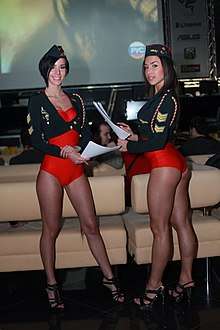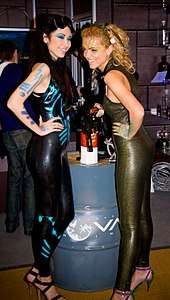Promotional model

A promotional model is a model hired to drive consumer demand for a product, service, brand, or concept by directly interacting with potential customers. A majority of promotional models typically tend to be conventionally attractive in physical appearance. They serve to make a product or service more appealing and can provide information to journalists and consumers at trade show and convention events.
Practice
This form of marketing touches fewer consumers for the cost than traditional advertising media, but the consumer's perception of a brand, product, service, or company, is often more affected by a live person-to-person experience. While each model may not be directly employed by the company they represent, they can be trained to answer questions and provide customer feedback regarding products, services, and brand appeal. The responsibilities of the promotional model depend on the particular marketing campaign being carried out, and may include: increasing product awareness; providing product information; creating an association in the consumer's mind between the product or brand and a particular idea; handing items to consumers, such as a sample of the product itself, a small gift, or printed information. Marketing campaigns that make use of promotional models may take place in retail stores or shopping malls, at trade shows, special promotional events, clubs, or even at outdoor public spaces. Promotional models may also be used as TV host/anchor for interviewing celebrities such as at film awards, sports events, etc. They are often planned at high traffic locations to reach as many consumers as possible, or at venues at which a particular type of target consumer is expected to be present.
The motorsports scene refers to promo models as race queens. In Japan, they are known as image models and are hired by government agencies.[1]
Spokesmodel

"Spokesmodel" is a term used for a model who is employed to be associated with a specific brand or product in advertisements.[2][3] A spokesmodel may be a celebrity used only in advertisements (in contrast to a "brand ambassador", who is also expected to represent the company at various events), but often the term refers to a model who is not a celebrity in their own right. A classic example of such spokesmodels are the models engaged to be the Marlboro Man between 1954 and 1999, and the Clarion Girl since 1975. Contrary to what the term suggests, a spokesmodel is normally not expected to verbally promote the brand.
Trade show model

A trade show model (also known as a convention model,[4] trade show hostess,[4] booth companion,[5] or booth professional;[6] a term that has been used only in Japan is companion lady[7] but today more often used is event companion (イベントコンパニオン)) is an assistant that works with a company's sales representatives at a trade show exhibit, working on the floor space or a booth, and representing a company to attendees. Such models are used to draw in attendees and can provide them with basic information about product or services, and may be used to distribute marketing materials or gather customer information for future promotions. Attire varies and depends on the nature of the show and on the image the company would like to portray, and they sometimes wear wardrobe that is particular to the company, product, or service represented.
Trade show models are typically not regular employees of the company, but are hired as they make a company's booth more visibly distinguishable from other booths with which it competes for attendee attention. If needed, they can explain or disseminate information on the company and its product and service, and can assist a company in handling a large number of attendees which the company might otherwise not have enough employees to accommodate, therefore increasing the number of sales or leads resulting from participation in the show. The models can be skilled at drawing attendees into the booth, engaging them in conversation, and at spurring interest in the product, service, or company.
Controversies
The slang term "booth babe", coined in 1986,[8] or "booth bunny", coined in 1989,[9] is widely used to refer to any female trade show model.[10] The models are typically asked to pose for photographs with convention goers, but inappropriate attendee conduct sometimes occurs, such as in case of Electronic Arts' 2009 "Sin to Win" campaign to promote Dante's Inferno.[11][12] Since the late 1990s and increasingly so,[13] the practice of employing them has been, controversially,[1][14] strongly criticized by some journalists and segments of video game industry and consumer electronics communities. Critics of "booth babes" declared it a sexist problem, describing the practice as "outdated", sexually objectifying and demeaning, as well as insulting to and alienating other women, in particular those in the information technology industry.[15] In turn, some others argue that the models and companies are being unfairly targeted, accusing the critics of finger-pointing sensationalism, displaying "extreme" political correctness, being prudish and pro-censorship, and spreading a Puritan-like moral panic.[16][17]
The moniker "booth babe" is also controversial itself as it is considered offensive and degrading by some,[4][6] including trade show models themselves.[17][18][19] The term nevertheless continues to be often used by journalists and by the people opposed to the presence of the models they define as "booth babes".

Changing social and business standards have resulted in a decrease in the use of promotional models in trade shows,[20] especially in the United States.[16] The largest video gaming business convention, Electronic Entertainment Expo (E3), attempted to ban "conduct that is sexually explicit and/or sexually provocative" in 2006 following Agetec's 2005 "Anti Booth Babe" protest,[21] but reversed on this stance in 2009,[22] after complaints regarding this and other policy changes.[8] GameSpot's Greg Kasavin commented that, with this attempt, the Entertainment Software Association (ESA) was "trying to put a definition to what constitutes scantily clad and what's borderline offensive" as it was "under a lot of pressure these days to clean up the image of games and to at least demonstrate that the video-game industry is responsible in regulating itself" in the aftermath of Hot Coffee mod controversy.[17]
China Digital Entertainment Expo & Conference (China Joy) introduced and strictly enforced a dress code in 2012,[23] saying they did not want "to send the wrong message" to their adolescent primary audience,[24] and San Diego Comic-Con International banned the SuicideGirls erotic models from having a booth in 2010.[25] Video game convention Penny Arcade Expo (PAX) adopted a dress codes for both male and female models[26] in what they call a "no booth babes" policy guideline, where "booth babes are defined as staff of ANY gender used by exhibitors to promote their products at PAX by using overtly sexual or suggestive methods. Partial nudity, the aggressive display of cleavage and the navel, and shorts/skirts higher than 4” above the knee are not allowed."[27] Eurogamer Expo did not allow them completely in 2012, saying they wanted to make a more "friendly" show and all visitors "to feel comfortable," with a formal guideline saying "Booth babes are Not OK."[28]
The Consumer Electronics Association (CEA), including its president and CEO Gary Shapiro[29] and senior vice-president Karen Chupka,[4] initially defended the use of female models who were deemed not dressed enough by critics but discouraged the practice in 2014 after a Change.org petition started by a Forbes technology journalist Connie Guglielmo demanded a ban on them and reached 250 signatures.[8] The campaigners' proposal to "ban booth babes" was rejected as the CEA refused to "create and impose arbitrary or unenforceable rules, or worse, inch our event towards a Talibanesque ban on exposure of skin,"[8] but the new Consumer Electronics Show (CES) exhibitor guidelines stated, "recent news articles show that ‘booth babes’ can reflect poorly on your exhibit, so we ask that you give this thoughtful consideration, to avoid alienating or offending various audience segments."[30]
_-_Sven_-_1D_X_MK_II_-_0527_-_AK8I5181.jpg)
After a round of talks with broadcasters, the Professional Darts Corporation announced on 27 January 2018 that it would discontinue the use of walk-on girls in darts tournaments. The decision has encountered a backlash from some fans, players and models.[31]
On 31 January 2018, Formula 1 management announced that it would end the practice of grid girls (also known as paddock girls or umbrella girls), who accompany the racers to the track, a tradition that "has been a staple of Formula 1 Grands Prix for decades", stating that "[they] feel this custom does not resonate with [their] brand values and clearly is at odds with modern day societal norms."[32] The move has drawn criticism from former grid girls, including British model Kelly Brook. Former F1 executive Bernie Ecclestone and Red Bull Racing leader Christian Horner also expressed disapproval.[33] In February 2018 Formula 1 announced it intended to replace 'grid girls' with a new programme called 'grid kids'[34] this season. The children used will be competitors in karting or junior categories, chosen by national motorsport authorities.[35] However, they were seen in Monaco Grand Prix this season.
See also
| Wikimedia Commons has media related to Promotional models. |
References
- 1 2 Feit, Daniel (21 June 2010). "E3 2010: In defense of booth babes". Venturebeat | GamesBeat. Retrieved 20 July 2014.
- ↑ "Spokesmodel | Define Spokesmodel at Dictionary.com". Dictionary.reference.com. Retrieved 18 June 2015.
- ↑ "Spokesmodel | Definition of spokesmodel by Merriam-Webster". Merriam-webster.com. Retrieved 18 June 2015.
- 1 2 3 4 Fox, Zoe (12 January 2013). "CEA on 'Booth Babes': The Name Is the Problem". Mashable. Retrieved 20 July 2014.
- ↑ Ashcraft, Brian (2 August 2012). "How China's biggest expo polices booth babes". Kotaku. Australia. Retrieved 21 July 2014.
- 1 2 Hardigree, Matt (30 November 2011). "New York Times adopts Jalopnik-coined term "Booth Professional"". Jalopnik. Gawker Media. Retrieved 21 July 2014.
- ↑ "babes, beautiful babes". Arcade (#1). December 1998. p. 15.
- 1 2 3 4 Kelion, Leo (10 February 2013). "CES 'booth babe' guidelines revised but ban rejected". BBC News. Retrieved 20 July 2014.
- ↑ "booth bunny". Word Spy. Retrieved 7 August 2015.
- ↑ Citations::
- Albanesius, Chloe (11 January 2014). "The Booth Babes of CES 2014". PCMag | News & Opinion. Retrieved 21 July 2014.
- Gibbs, Mark (17 July 2014). "Testing the effectiveness of booth babes". Network World. Retrieved 21 July 2014.
- "The 100 hottest booth babes (Part 1)". GamesRadar. Archived from the original on 13 August 2014. Retrieved 21 July 2014.
- Carle, Chris (17 June 2011). "The 10 Hottest Booths at E3 - IGN". Uk.ign.com. Retrieved 21 July 2014.
- ↑ Leray, Joseph (24 July 2009). "SDCC: EA to prostitute its booth babes for you, the customer". Destructoid. Retrieved 20 July 2014.
- ↑ McElroy, Griffin (26 July 2009). "Dante's Inferno team apologizes for 'Sin to Win' booth babe contest (blog)". Joystiq. Weblogs, Inc. Retrieved 26 August 2013.
- ↑ Ludwig, David (7 January 2013). "A Brief History of CES Booth Babes". The Wire. Retrieved 20 July 2014.
- ↑ Other citations::
- Weissman, Jason (July 2009). "In Defense of 'booth babes' at E3 (sort of)". Gamerant.com. Retrieved 20 July 2014.
- Chipman, Bob "Moviebob" (20 August 2013). "In defense of "booth babes" (sort of)". Escapist Magazine | The Big Picture Video Gallery. Retrieved 20 July 2014.
- Hall, Steve (July 2009). "In defense of booth babes and why they're here to stay (blog)". Adrants. Adrants Publishing. Retrieved 20 July 2014.
- Mahan, Molly (18 July 2012). "Heroine addict: defending cosplay and (variably) the booth babe". Geekscape. Retrieved 20 July 2014.
- ↑ Citations::
- Florence, Rab (3 October 2012). "Lost Humanity 15: Booth Babes". Eurogamer. Retrieved 26 August 2013.
- Mahdawi, Arwa. "Smart forks and booth babes at CES: the cutting edge of innovation | Comment is free". The Guardian. Retrieved 20 July 2014.
- ALLI (23 March 2012). "Surprise! I'm not a booth babe". xoJane. Retrieved 20 July 2014.
- Gye, Hugo (13 January 2012). "Women criticise 'insulting' booth babes who use their looks to sell technology". Daily Mail. Retrieved 20 July 2014.
- Blue, Violet (13 January 2012). "The CES 2012 booth babe problem". ZDNet. Retrieved 20 July 2014.
- The Week Staff. "Is it time for trade shows to banish 'booth babes'?". The Week. Retrieved 21 July 2014.
- 1 2 Gollom, Mark (17 January 2013). "'Booth babe' controversy continues to have legs". CBC News | World. Canada. Retrieved 21 July 2014.
- 1 2 3 Silverstein, Jonathan (2 February 2006). "Sexy 'Booth Babes' Under Siege". ABC News. Retrieved 21 July 2014.
- ↑ Peterson, Andrea (25 July 2013). "Here's what it's like to be a 'booth babe' at cybersecurity's biggest conference". The Washington Post. Retrieved 20 July 2014.
- ↑ Fremling, Alicia (10 January 2014). "CES 2014: What it's like to be a "booth babe" at trade shows". Slate. Retrieved 20 July 2014.
- ↑ Sorensen, Jean (February 21, 2011). ""Booth babes" fading from tradeshow floors". Journal of Commerce. Reed Elsevier inc. Archived from the original on 13 July 2011. Retrieved 19 February 2011.
- ↑ Citations::
- Lees, Jennie (23 January 2006). "Censorship at E3 (blog)". Joystiq. Weblogs, Inc. Retrieved 26 August 2013.
- Glaister, Dan (16 May 2006). "Decline of the booth babe". The Guardian | World news. Retrieved 20 July 2014.
- Cangeloso, Sal (13 May 2005). "Company takes stand against booth babes". Geek.com | xyzcomputing. Retrieved 21 July 2014.
- Terdiman, Daniel (23 March 2009). "Despite controversy, 'booth babes' still prowl E3". CNET News. Retrieved 21 July 2014.
- ↑ Purchese, Robert (28 April 2009). "E3 Booth babes to return this year". Eurogamer. Retrieved 26 August 2013.
- ↑ Matyszczyk, Chris (2 August 2012). "Gaming expo in China bans booth babes". CNET. Retrieved 21 July 2014.
- ↑ Carter, Johnathan Grey. "Chinese gaming expo bans booth babes | The Escapist". Escapist Magazine. Retrieved 21 July 2014.
- ↑ Rogers, Vaneta (22 July 2010). "Comic-Con wrestles with 'booth babe' controversy". Newsarama. Retrieved 21 July 2014.
- ↑ junglist (24 July 2013). "So why were there booth babes at PAX Aus?". Kotaku. Australia. Retrieved 20 July 2014.
- ↑ Staff writer. "PAX Prime - Seattle, WA Aug 29-Sep 1, 2014". Prime.paxsite.com. Retrieved 20 July 2014.
- ↑ Rupert (3 October 2012). "Booth babes and the expo (forum message)". Eurogamer.net. Retrieved 26 August 2013.
- ↑ Danzico, Matt (12 January 2012). "'Booth babes' stir controversy at 2012 CES". BBC News. Retrieved 20 July 2014.
- ↑ Duhaime, Arielle (10 January 2014). "Why can't CES quit booth babes?". The Verge. Retrieved 20 July 2014.
- ↑ Staff writer (27 January 2018). "Darts: PDC to scrap walk-on girls after broadcaster talks". BBC Sport. Retrieved 31 January 2018.
- ↑ de Menezes, Jack (31 January 2018). "Formula 1 to get rid of grid girls before grand prixs in response to darts ban". The Independent. Retrieved 31 January 2018.
- ↑ Citations::
- Wheatstone, Richard (3 February 2018). "Who are the Formula 1 grid girls, how much do they get paid and why are they being banned?". The Sun. Retrieved 4 February 2018. (Subscription required (help)).
- McKern, James (15 December 2017). "'Tarty nonsense': F1's shock grid girl plan". NewsComAu. Retrieved 4 February 2018.
- Bhutia, Jigmey (3 February 2018). "Kelly Brook backs F1 grid girls with her throwback photos". International Business Times UK. Retrieved 4 February 2018.
- Benson, Andrew (31 January 2018). "Formula 1: 'Grid girls' will not be used at races this season". BBC Sport. Retrieved 4 February 2018.
- ↑ NAANII GLOBAL Motorsport & quality family Lifestyle -Magazin 'en Vogue'-,(21 march 2018), www.naaniiglobal.com, 'First ever australian 'F1 Grid Kids', passioned Karting driver, met with Daniel Ricciardo prior Australian F1 GP 2018'
- ↑ Benson, Andrew (5 February 2018). "Formula 1: 'Grid kids' to replace 'grid girls' from start of the season". BBC Sport. Retrieved 23 February 2018.
.jpg)